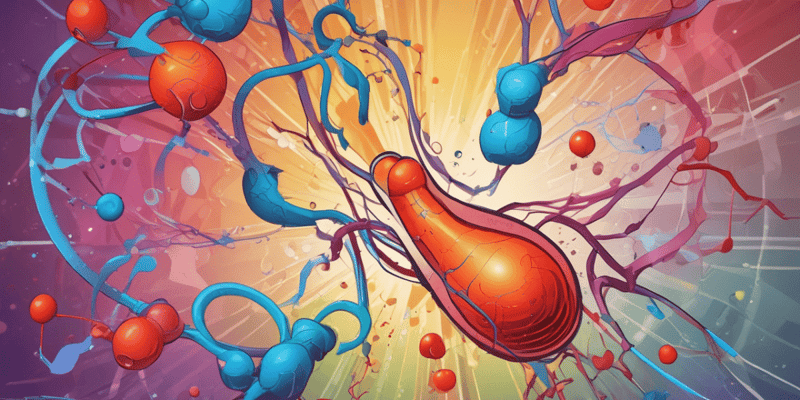24 Questions
What is the units of [S] in the given data?
μmol/L
What is the relationship between kcat and Vmax?
kcat [E]t = Vmax
What is the purpose of plotting 1/v vs 1/[S]?
To estimate Vmax and Km
What is the value of x intercept in the plot of 1/v vs 1/[S]?
-1/Km
What is the units of v in the given data?
μmol/(L min)
What is the equation of the line in the plot of 1/v vs 1/[S]?
y = 0.1961x + 0.0061
What is the purpose of verifying that Km/Vmax has units of time?
To ensure that the equation is correct
What is the relationship between Vmax and kcat?
Vmax ≠ kcat
What is the value of R² in the given graph?
0.9995
What is the unit of Vmax in the given equation Vmax = kcat [E]T?
μmol/min
What is the function of the zinc atom in the active site of liver ADH?
It stabilizes the negative charge
What is the unit of kcat in the given problem?
s⁻¹
What is the role of the histidine in the active site of liver ADH?
It pulls the H+ off the active-site serine
What is the product of the reaction catalyzed by liver ADH?
Acetaldehyde
What is the unit of kcat/Km in the given problem?
L/(mol s)
What is the equation that describes the enzyme reaction?
V = Vmax [S] / (Km + [S])
What is the primary function of enzymes in biochemical reactions?
To lower the activation energy
How do enzymes stabilize the transition state?
By stabilizing the charged transition state
What is the function of glucokinase in the liver?
To convert glucose to glucose-6-phosphate
Which glucose transporter is responsible for glucose uptake in the CNS?
GLUT III
What is the characteristic of GLUT II in the liver and β cells of the pancreas?
High capacity, low affinity
What is the purpose of the two-way transporter in liver hepatocytes?
To facilitate both glucose uptake and release
What is the role of GLUT I in the RBC?
To facilitate glucose uptake
Which enzyme is responsible for converting glucose to glucose-6-phosphate in other tissues?
Hexokinase
Study Notes
Enzymes and Biochemical Reactions
- Enzymes are catalysts that accelerate the rate of biochemical reactions by lowering the activation energy.
- Enzymes achieve this by bringing reactants into close proximity, stabilizing the charged transition state, and using general acid-base catalysis, covalent catalysis, and metal ions.
Glucose Transporters
- Hexokinase is found in other tissues, while glucokinase is found in the liver.
- GLUT II is a high-capacity, low-affinity transporter found in the liver, β cells of the pancreas, and kidneys.
- GLUT II is a "two-way" transporter that allows for both uptake and release of glucose.
- GLUT I is a high-affinity transporter found in RBC and GLUT III is a major CNS glucose transporter.
Michaelis-Menten Kinetics
- The initial rate of an enzyme-catalyzed reaction is determined by the substrate concentration.
- The Michaelis-Menten equation is v = Vmax * [S] / (KM + [S]), where v is the initial rate, Vmax is the maximum rate, KM is the Michaelis constant, and [S] is the substrate concentration.
- The Lineweaver-Burk plot (1/v vs 1/[S]) is used to estimate Vmax and KM.
- In the given example, Vmax ≈ 140 μmol/L min-1 and KM ≈ 160 μmol/L.
Enzyme Kinetics Calculations
- The turnover number (kcat) is calculated as kcat = Vmax / [E]T, where [E]T is the total enzyme concentration.
- In the given example, kcat = 135 μmol/L min-1 / 1.0 nmol/L = 135,000 min-1.
- To calculate kcat in units of s-1, divide by 60 (60 s = 1 min).
- kcat/KM has units of L/(μmol min) and represents the enzyme's efficiency.
Liver Alcohol Dehydrogenase (ADH)
- Liver ADH catalyzes the oxidation of ethanol to acetaldehyde.
- The active site of liver ADH contains a bound zinc atom, a serine side chain –OH, and a histidine nitrogen that participate in the reaction.
- The histidine pulls an H+ off the active-site serine, which pulls the H+ off of the substrate –OH group, leaving the oxygen with a negative charge that is stabilized by zinc.
Learn about the role of enzymes in biochemical reactions and the different types of glucose transporters in the body.
Make Your Own Quizzes and Flashcards
Convert your notes into interactive study material.
Get started for free



